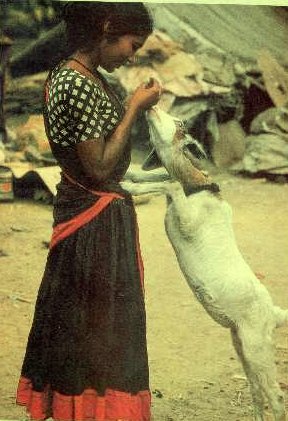

Home | Biodata | Biography | Photo Gallery | Publications | Tributes
[Back to Narikorava Studies]

 |

Home | Biodata | Biography | Photo Gallery | Publications | Tributes [Back to Narikorava Studies] |
 |
There are a number of families of the Narikorava tribe who have been living in and around Madras City for more than a decade. They shift their sites of residence every few months but they remain in the vicinity of Madras. For instance a family living at Ayanavaram will shift to Tambaram and the family living at Meenambakkam will shift to nearby Pallavaram.
They snare domestic cats in residential areas using portable snares. They also rear pigs. In addition to rearing the "country pigs" they also rear the Yorkshire or "white pigs". The women make bead necklaces which are sold in Madras and in Tirupathi.
There is also a moving population of Narikoravas who visit Madras for a few weeks and then go back to their respective areas in the districts. City Narikoravas wear fewer bead necklaces compared to the district Narikoravas.
A census [M.Bagavandas, "The Gypsies of Madras City", (Tamil, Mimeo), STAT 18/73, Department of Statistics, Madras Christian College] was taken of the Narikoravas of Madras City in 1972 on Gandhi Jayanthi Day, by our students of statistics. It was found that there were about five hundred people of the Narikorava tribe living in Madras City, within the city limits.
Two-fifths of them lived on the platforms. A third of them lived in their little tents which they carried along with them. One-fifth of them lived more or less permanently in the city in unhygienic conditions.
There are older people who had been named after places or towns in which they had been born.. There is a man called Kodambakkam and another called Thanjavur and so on. In the recent past children are named after film-stars and political leaders. (Some children have been renamed in recent years). There is a girl called Indira Gandhi belonging to the tribe who is studying in a school at Saidapet called Thiruvalluvar Gurukula pa$dasa$lai. It is a special school run primarily for Narikorava children by Mr Raghupathy, a teacher and social worker.
It has been generally held that there are four exogamous divisions among the Narikoravas. The divisions are Me$va$do, Gujara$thi, Se$lio and Dha$bi. In our census we came across another division called the pava$r. Further the rules of exogamy are not strictly followed by the people. They also follow a system similar to the go$tra system but it is not strictly adhered to in practice.
Being travellers they can speak in many languages and would like their children to learn several languages. Only about one-fifth of them wish to have the children learn Vaagri Boli in school in contrast to forty-eight percent who opt for English. Tamil tops the list with three-fourths of them wishing to learn it in schools.
Both Tamil and English are taught to the Narikorava children at Thiruvalluvar Gurukula Pa$dasa$lai. Once the children are given a haircut and the normal dress, it is impossible to make them out as Narikorava children. One of our charming young women students who took part in the Narikorava census was mistaken by the women of the tribe for an educated gypsy.
About three-fourths of the tribal people expressed the wish that their children should give up the nomadic way of life and a vast majority of them would like their children to get educated. Less than one-fifth of them would like children to continue to live as they do but would like them to be educated to some extent.
Each group of the gypsies has a leader who takes all the important decisions for the group. One of the questions that faces these men is whether to get their hair cut and join the rest of the people or continue to live in their old ways. "Let the leader change first", says the average Narikorava, "then we shall change".